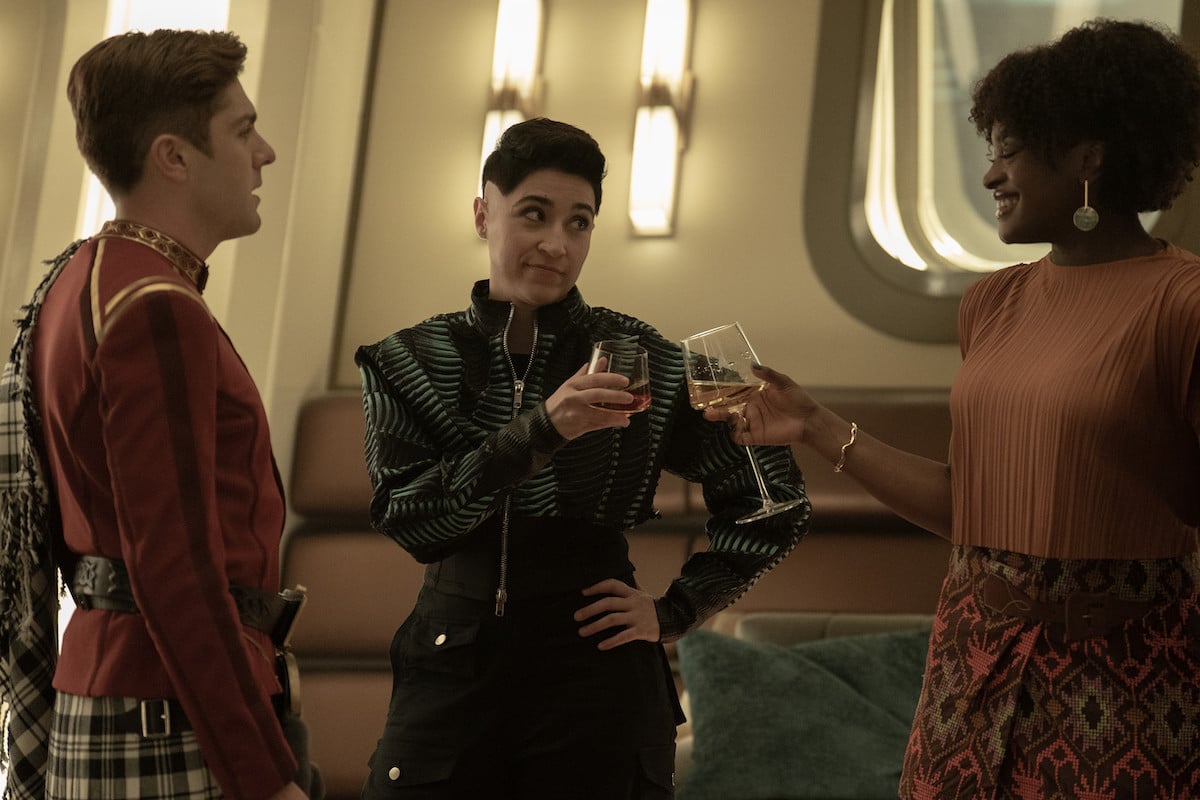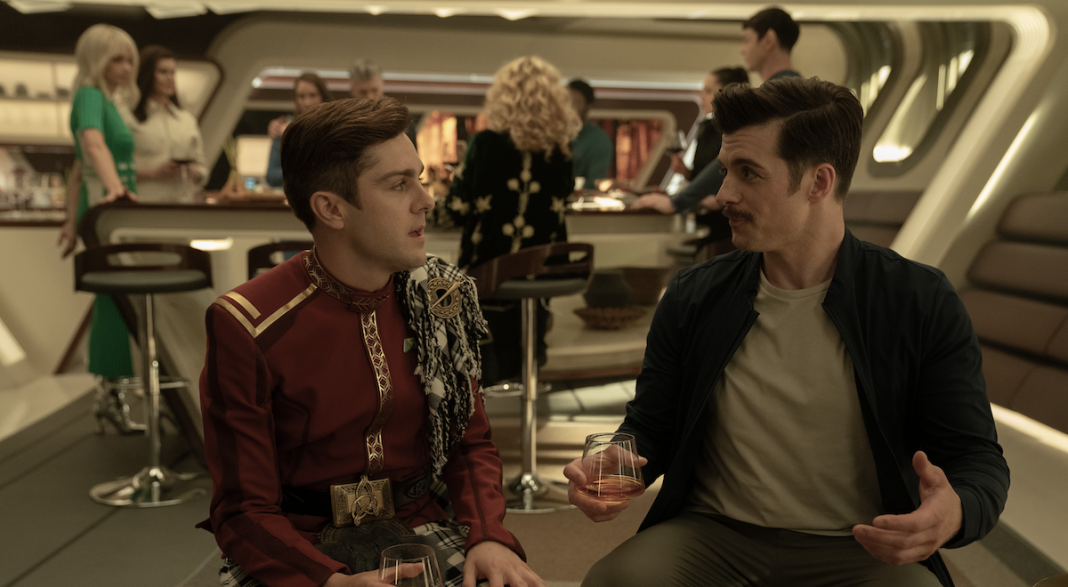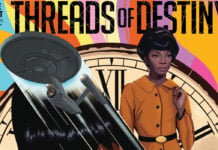Welcome to Comics Beat’s Star Trek: Strange New Worlds Season 3 roundtable discussion! With Strange New Worlds Season 3 having concluded, The Beat’s Star Trek team has gathered in Stately Beat Manor’s Observation Lounge to discuss what we’ve seen.
Please note: This discussion includes SPOILERS for all of Strange New Worlds Season 3.
Read our Strange New Worlds Midseason 3 Roundtable here, and check out our Star Trek Day 2025 Roundtable here.
Cover Photo Credit: Marni Grossman/Paramount+
What did you think of the back five episodes of Strange New Worlds Season 3?
GEORGE CARMONA 3rd: The bottom five episodes of the season have some of the strongest episodes that I enjoyed the most, like “What is Starfleet?” and “The Sehlat Who Ate Its Tail.” Those were solid episodes that I enjoyed, but overall, the season itself was a mixed bag. I feel like they’ve gotten a little in their own way in the writing of the show; it’s the same trap that the writers of Star Trek: Enterprise fell into, creating fan service episodes. This is supposed to be a show about exploration and strange new things, and there are a lot of new things we could see that don’t involve holodecks, Q-like entities, or mind melds. This season wasn’t as strong as season two, but the bottom half of the series saved it.
DERRICK CROW: Much like the first half of the season, it was fraught with badly conceived concepts that aren’t utilized to their full nature (“What is Starfleet?”) or dive headfirst into some baffling eugenics territory (“Four-and-a-Half Vulcans”). George is right in that this show, especially in this season, has chosen to become a fan service-driven show rather than what it once was, which was more character-driven, or at least had character growth, which is sorely lacking in this season. If that finale had been the series finale, it would’ve been one of the worst finales I had seen in awhile.

AVERY KAPLAN: I thought the back half had some of the season’s best episodes and some of the season’s worst. I guess it is inevitable that you will have some misses when you are making big swings. But I also feel like Seasons 1 and 2 pulled off some very big swings with a better overall result (and no episodes like “Four-and-a-Half Vulcans”).
I agree with George that this season became too beholden to previous continuity, especially Star Trek: The Original Series. As I have said before, I have no real interest in Star Trek: Year One; give me strange, new crews and stories! It’s one thing if this is just one flavor among several Star Trek shows, but when the roster has been so reduced, it’s not what I want as the only sustenance for the Franchise. I am concerned that Strange New Worlds Seasons 4 and 5 will only serve as an extended “backdoor” pilot for Year One. The fact that even the title is a Batman ripoff is fitting. Give me less Year One, more “In the Pale Moonlight.”
OLLIE KAPLAN: I don’t know if I disliked Season 3 with the same vitriol as some Trekkies, but I also don’t have much to say about it. I think that “Terrarium,” which is the episode where Erica Ortegas (Melissa Navia) must learn to work together with a female Gorn pilot (Warren Scherer) so that the two of them can survive the hostile conditions of the planet that they are on. The whole season has continued Season 2’s heartfelt exploration of how the Klingon war impacted Ortegas and other Enterprise crew members. While other crew members (like M’Benga) started their PTSD recovery journey in Season 2, Ortegas needed more time to heal—and that healing was seen in the episode “Terrarium.”
While a lot of the season seemed to bumble through core Trek values (like overcoming implicit biases and prejudicial beliefs), “Terrarium” reminds me of James T. Kirk’s journey in Star Trek: Undiscovered Country, where he begins to acknowledge that while his trauma is legitimate, it’s against Starfleet’s values to use that trauma to justify his hatred of an entire group of aliens. Showing imperfect people work through their trauma—and the resulting prejudices—to become better people who embody the IDIC philosophy is one of my favorite things about the Star Trek franchise, at least when it’s done thoughtfully as it was done in both of the instances I mentioned here.
What did you think of the season 3 finale in particular?
GEORGE CARMONA 3rd: On my first watch, it was a bit up and down. I really wasn’t too sure about how much I liked it until I rewatched it. It felt very rushed in moving the plot. First, there was a waste of a villain, because as much as I love seeing Chris Myers as Ensign Gamble reprise his role and get a check, maybe there could have been something more, and I could have done without the Kirk/Spock mindmeld. With that, sending Captain Batel off in a heroic fashion was a nice end to her story. And ultimately, the payoff for this episode is the Pike and Batel montage scene, with their version of “The Inner Light,” getting to live out their lives and be happy. Tears were fought back.
DERRICK CROW: As alluded to in my previous answer, I really didn’t enjoy it. Again, I agree with George that it was a waste of a villain–and overall a character in Gamble–and Batel’s ending does not serve her character arc in the slightest? What even was her character arc? She got sloshed up like a petri dish in the beginning half of this season, spent the season desperately wanting to get back to work, somehow got superpowers in this episode because her DNA is blended with that of other races, and then decided to become a statue, of which she has no actual attachment to other than the writers said she does? And the scene with her and Pike could’ve been nice had the dialogue between them throughout that montage been written better. And when you notice that the Skygowan people are doing absolutely nothing but standing around while the crew literally Vulcan pinches some guards, opens a portal twice, once with the laser beams of two starships fired at the planet, serving as literal background pieces while their home is threatened…it all becomes laughably dull. The stakes they want us to imagine are at odds with what you can see on the screen, which is that no one but the crew cares.
AVERY KAPLAN: I wasn’t a fan. I thought it felt more like an episode of a fantasy TV series than a Star Trek episode. And I feel that the mind meld between Kirk and Spock is the bone that queer viewers are being thrown. I don’t like it. Just let Spirk happen properly; Trekkies have been campaigning for it since the 1960s, and there’s more than enough textual evidence to support it.
Or at the very least, have another member of your voluminous cast engage in anything other than what at this point feels like compulsive heterosexuality. That’s not what Star Trek is about, and if it has to be made into that to appease government stooges or terminally online CHUDs, then it will no longer be Star Trek. Star Trek: Lower Decks, Star Trek: Prodigy and Star Trek: Discovery all handled relationships much better than Strange New Worlds has in this third season.
OLLIE KAPLAN: I know I didn’t dislike the finale as much as Avery, as the episode has produced hours of discussion in our house—and an episode that leads to that much discussion must have something, right? What I disliked about the episode seems to be different than the primary online criticism (which is similar to what Avery said, that it’s less of a sci-fi story and more of a fantasy one). Instead, I didn’t like how it handled Pike and Batel’s relationship. It felt like an attempt to satisfy all the fans, rather than a well-thought-out element of the plot. At least, I would have liked Batel to ask Pike for his consent before she whisked his consciousness off to live through some version of the life they could have had together if she hadn’t had to take over the role of the statute.
If it were me (and maybe we will see this explored in Season 4), it would add to the loss I felt, not mitigate it. Now, not only does Pike have to mourn the loss of Batel, he also has to mourn the children they could have had (or did have?) together.
What was your favorite episode of the season?
GEORGE CARMONA 3rd: The strongest episode for me was the documentary episode, “What is Starfleet?” It resonated with me in a way that felt new and exciting in Star Trek. We’d seen people reporting, but I thought this documentary style of shooting was an interesting take. There was something with the directing and the camera angles they chose, using static positions and no cameras swiveling around the space. It was quintessential Star Trek; there’s a mission with a space entity, and the crew has to figure out that the people they were helping were really enslaving it. Having that fundamental Star Trek value that we’ve come to know, mixed with a new visual styling, made it my favorite episode of the season.
DERRICK CROW: My favorite episode of the season was “Terrarium.” It was really nice to see Ortegas get a spotlight episode for once. Long overdue.

AVERY KAPLAN: I agree with Derrick: it’s impossible to beat “Terrarium.” We’ve been waiting a long time for Ortegas to get her moment to shine, and an equally long time to see the Gorn represented as subjects rather than inhuman monsters. My biggest frustration here is that I wish they had let the Gorn pilot join the Enterprise crew, even if only for half of season 4. I know it pushes against continuity, but they destroyed the whole U.S.S. Discovery. I’m sure they could scrub one little Gorn from the ship’s records. And think of the subplots with Ortegas and La’an!
OLLIE KAPLAN: Thirding “Terrarium.” While I know this opinion is controversial (and I reserve the right to change my mind as I read more people’s opinions), I really enjoyed “Four-and-a-Half Vulcans,” despite the fact that Anson Mount should probably never play a Vulcan again. I know that many of the characters did pretty messed-up things while in their Vulcan forms, but their lack of true Vulcan socialization may explain why they didn’t always make the best decisions. To me, there is a straightforward scientific explanation of why the characters had Vulcan traits, even if they weren’t raised on Vulcan, and that’s epigenetics.
According to that field of study, our intergenerational social histories influence gene expression, which could explain how the crew developed socialized Vulcan traits after taking a serum. With those genetically passed-on social behaviors, it can also explain why the crew responded to Spock in the same hateful way his Vulcan peers do. Mostly, I think the episode was there to be foils for Spock as he travels down the path of becoming the character we all know and love.
Did you have a least favorite episode of season 3?
GEORGE CARMONA 3rd: The Trelaine “Wedding Bell Blues” episode was unnecessarily over the top, and I really wished they had taken that out so that the season finale could have had two hours, so it could have breathed a little bit more. And now we’re really just messing with the canon of it all, because how are we going to have a whole room full of Starfleet personnel meet some godlike being and not remember, talk about it, or be news throughout the fleet, or the Federation, for that matter.
DERRICK CROW: Unfortunately, I have to say “What Is Starfleet?” was my least favorite episode. It started out pretty promising, but then eventually dovetailed into refusing to answer any of the questions it set forth, tried to shoehorn in some character beats for Beto that were literally never set up before, and underused the conflict aspect of the story, which goes nowhere within the narrative in favor of this Jikaru storyline. It just fails in nearly everything it set out to do.
AVERY KAPLAN: The season finale. It really did not do it for me. “Sufficiently ridiculous sci fi is indistinguishable from fantasy.” Derrick mentioned above that it was possible this might have been Strange New Worlds’ series finale, and that would have been tragic. I think “These are the Voyages…” was a better series finale. Yeah, I said it.
OLLIE KAPLAN: I think the season premiere. I don’t know if I have a well-thought out reason as to why. It just didn’t speak to me.
AVERY KAPLAN: It was very similar to the Season 2 finale. I know it was part 2 of that episode, but Strange New Worlds‘ whole thing is that each episode has its own flavor.
What do you hope to see from Strange New Worlds Seasons 4 & 5?
GEORGE CARMONA 3rd: What the next two seasons shouldn’t be is staging for the Original Series characters. We don’t need to see young Sulu or McCoy join the crew of the Enterprise. What I need are great send-offs for Una, La’an, and Ortegas, give them their commands. And if we have to do a last stunt episode, a crossover with Discovery would be amazing, as I would love for Spock to see his sister one last time.
DERRICK CROW: I also agree that I hope they don’t tee up the original series too much when this show’s main focus should be on this crew and this era of the Enterprise. I want them to continue making fun, strange episodes, though it’d be cool to visit more strange worlds rather than them just having strange adventures on the Enterprise, but get back to all the incredible character work that was present in those same episodes in the first two seasons. That’s what I loved. Come for the fun, stay for the emotion. This season has been lacking in that. I want this show to get back to its core strengths. Ultimately, focus on telling some really compelling stories and I will reiterate and agree send-off this crew properly. I don’t need teases for another show that may never happen or yet a different show that is going to be 60 years old next year.
AVERY KAPLAN: I adore George’s idea that we might get a crossover episode with Discovery in Strange New Worlds’ final two seasons. Maybe Michael and Book time travel back to Strange New Worlds; working with Daniels must have its perks, after all. It would work great as a penultimate episode, allowing Spock to see his sister and seeing how Pike reacted to a leveled-up Michael. And I can see both Uhura and La’an getting something out of meeting Michael as well. Then the Strange New Worlds finale could be used to wrap-up the show’s subplots.
While Discovery makes the most sense, I’d also enjoy another Lower Decks crossover – maybe this time the Enterprise crew could visit the animated U.S.S. Cerritos. Both of these crossovers could give us a glimpse at what happened on those shows post-finale, too, which would be a neat bonus. Just as long as the Strange New Worlds finale isn’t a holodeck simulation on Discovery or Cerritos, it should be fine.

OLLIE KAPLAN: I really want the series to explore the queer storylines that I loved in Season 1. These Strange New Worlds storylines not only added the diversity that Gene Roddenberry originally wanted in early Star Trek, but they also represented the world we now live in. Despite MAGA’s efforts, the number of queer people in America is on the rise and we will not quiet down. And I want the franchise to reflect that. I want to know more about the bisexual past of Christine Chapel (Jess Bush), Ortegas’s sexuality and the beginning of the Spirk relationship that fans love.
On that note (and in line with what Derrick said), I hope the series continues to push the envelope but in a way that honors these characters. The Season 2 musical episode was a great example of that—while fun and silly on its face, the episode actually did a lot of story legwork, setting the characters on the trajectory to become the people we know in The Original Series.
The current streaming home for the Star Trek Franchise is on Paramount+.
Keep up with all of The Beat’s Star Trek coverage here.












so there is no such thing as a natural manly friendship in american television any more ? That is just a shame.
What is that even supposed to mean?
(You also clearly don’t watch a lot of TV.)
Imagine showing up six decades late to the Spirk conversation LOL
Comments are closed.